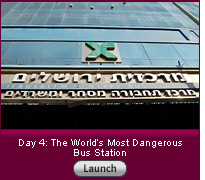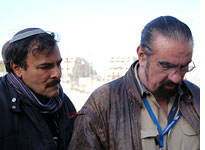A Terror Tour of Israel
By Day 4 of our tour of terror, one thing was certain: Paranoia was getting the better of us. We saw potential "hotspots" everywhere, and the security line in front of the bus station was now a chokepoint where we would be stranded in case of attack. What better target than a group of foreigners traveling in a bus prominently labeled with the sign: "THE ULTIMATE COUNTER-TERRORISM MISSION."
Israel's mass transportation system is particularly high on the list of places to avoid, especially after reading up on the wave of suicide attacks aimed at buses and bus stations. It was precisely that series of bombings that led to the opening in 2002 of Jerusalem's new bus terminal, which was designed to incorporate new security procedures (and accommodate increased commuter traffic). Today, every person who enters the station must pass through a metal detector and put their baggage through the X-ray machine.
Well, almost everyone. A few words were exchanged between our tour leaders and security, and our group was suddenly herded through the checkpoint with the wave of a hand. It helps to have a personal escort from the chief of security. Once past the gate, we entered the cavernous shopping-mall interior, where army conscripts on leave mingled with civilians shopping for mobile-phone accessories and lining up for slices of pizza. Just a few years ago, the bus attacks held Israelis in the grip of mass anxiety, a sort of collective nightmare that has become a rich, raw subject for everything from documentary films to graphic novels. Today, the new bus terminal is one of the country's main transportation hubs, and everything has a sort of eerie placidity.
We were led through the underground parking lot to the main security command post, where a handful of guards were monitoring a bank of TV screens. A network of 84 closed-circuit cameras can peer into almost every corner of the bus station, but the security professionals in our group were less than impressed: Beyond the CCTV system, the bus station featured none of the fancy biometric detection technology that has been developed in Israel. The chief of security even conceded that his security officers were not on the lookout for anything beyond "suspicious behavior."
Still, the security measures were strict, at least compared with a Greyhound terminal. We had more questions, but our guides were eager to show us the next attraction. "Come on, guys!" tour leader Yossi Maimon said. "We're going to see a bulletproof bus."
Rows of the hulking green vehicles, which ply the more hazardous routes to settlements in the West Bank, were lined up in the underground parking garage. Security comes at a price. A bulletproof bus—which features a blast-resistant hull and ballistic glass—costs twice as much as a regular bus, more than half a million U.S. dollars. While well-armored, they are not invulnerable; they come equipped with GPS tracking systems and video cameras that allow army headquarters to hear and see inside the bus in an emergency.
To the casual observer, Israel's bus terminals have the level of security you might find at a U.S. airport. But security at the Jerusalem Central Bus Station was nothing compared with Ben-Gurion International Airport, where we were also treated to a similar behind-the-scenes tour.
Ben-Gurion is supposed to be the gold standard for airport security. And it has an impressive track record: While there have been terrorist attacks directed at the airport, no aircraft originating from Ben-Gurion has been successfully hijacked. That makes it an attractive model for U.S. airports. Airport security directors from the United States have visited Ben-Gurion to study Israeli security; Boston's Logan International Airport even hired its former director of security.
But if Israel is the model for airline security, then what we saw stood in surprising contrast to what is going on in U.S. airports. The U.S. Transportation Security Agency is pouring millions into new-fangled contraptions ranging from facial readers that will detect "hostile intent" to shoe-bomb screening equipment. But walking through Ben-Gurion airport, we realized that the focus was not on the technology, per se. The system instead relies on layers of security that begin at the outer perimeter of the airport, which is cordoned off with the same kind of pressure-sensitive fencing used in Israel's security barrier. All vehicles pass through an inspection long before they approach the terminal.
Nahum Liss, the head of security at Ben-Gurion, did not go into great detail on what is the most controversial aspect of airport security in Israel: ethnic profiling. Just last year, Israel did away with tagging luggage by color, a system that was accused of discriminating against Arabs, but Palestinians and Arab-Israelis still frequently complain of extra screening. Liss, for his part, claimed that profiling didn't focus exclusively on looking for terrorists; rather, they are looking for people duped into carrying something for a terrorist. "We can detect an attacker, we are not afraid of that," Liss told us. "We are afraid of other passengers who are naive or innocent. That is our big concern."
After an hourlong lecture by Liss, we were escorted into a back area, a dismal, utilitarian room decorated with tattered old posters, including one that read, "Have Faith in Israel." Those selected for an additional round of screening—based on profiling—are taken here for further questioning or body searches. A bottle blonde wearing the uniform of the Russian devushka (hot pants, Prada bag, and stiletto-heeled boots) emerged from a dressing room. In fact, one of the members of our tour group, a Japanese-American woman, had already paid a visit to this same room; upon her arrival, security officials were apparently suspicious of the visas for Afghanistan and Iran in her passport and had questioned her for half an hour. So, what, then, is the profile of a terrorist?
Halfway through our tour, we paused to take a break on the tarmac, where we realized that we—a motley group of foreigners with backpacks and digital equipment—had ambled through the world's most secure airport, including off-limits areas, without so much as a pat-down. No metal detectors, no X-rays, not even an ID check. Sitting in clear view of airplanes waiting for international flights, we wondered what could justify such a breach. Was this evidence of what Liss called a "common sense" approach to security or simply proof that no system is completely fail-safe?
As we walked out through the employee gate, we stopped at the bin of confiscated items—a huge collection of nail scissors and other forbidden objects. One of the things Liss mocked—even though Israel complied—were demands that such seemingly innocent items be confiscated. What is the point, Liss asked, of taking away nail clippers from a pilot who could easily send the plane into a suicidal plunge?
"There is no 100 percent security," he said. "If you want 100 percent security, you'll get zero percent aviation activity."

